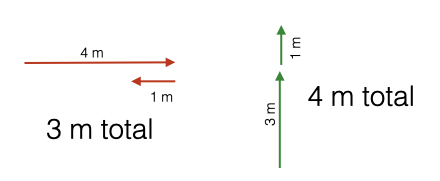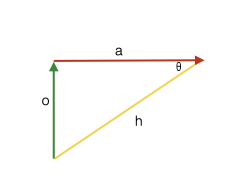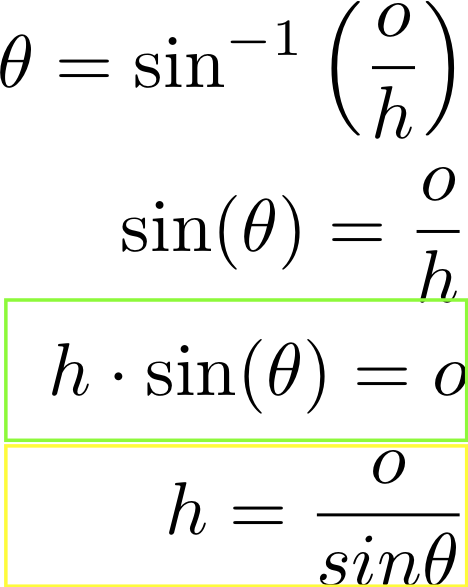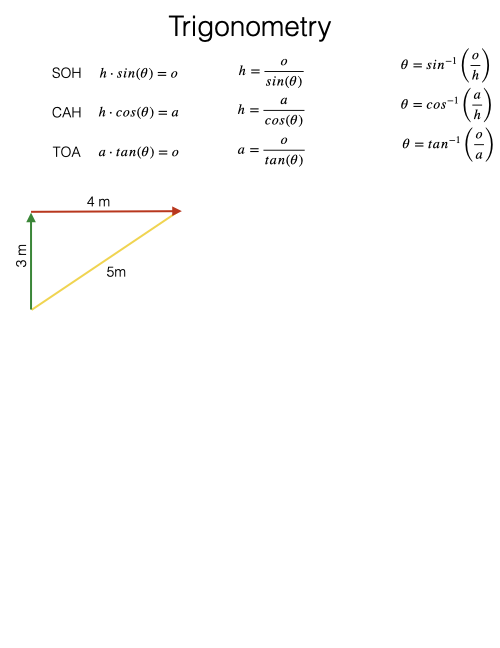More on Vectors
Intro and Rant
I want to try to expand on vectors here, specifically how to work with them. To do this, I’m going to focus on displacement and useful trigonometry. Why displacement?
Displacement is probably the most straightforward concept to deal with in physics. You deal with distance every day: driving, walking, running, biking, hiking… You also deal with directions every day: up north street, four blocks west, 295 North 10 km…
Why trig though? 2 reasons:
1) you need trig to deal with vectors at an intro physics level. Without trig, honestly you won’t be able to move forwards.
2) The first hand experience I’ve had with the American Educational System (and a later extent how students treat school). I will not go on a long rant here, what I will say is if any university or college reads this: Shame on you. You are doing no services telling students to take pre-calc and calc for econ, biology, buisness, and the like. You are further doing no services guiding your freshmen the way many schools do. The students I have tutored or taught frequently did not understand this level of mathematics after taking pre-calc for biology or econ, or what options were available to them and this prevents them from being competitive later on in life. If you have a complaint about this statement email me here. I have spent a lot of time thinking how to try and fix this, and I am more than happy to talk.
Vectors: quick review
Reminder, what is a vecto? A vector is a measurement with a direction associated with it: I walked 4 km east for example. Vectors can only be added or subtracted to like unit vectors: meters in the x direction to meters in the x direction for example.

you want to know the total distance from vectors in multiple directions, you must take the magnitude (labled as h in the equation):

Vectors and Trig
The sum of the angles of a triangle add to 180 degrees (I will drop degrees at this point ie it’s going to be a unitless number). For the case of these examples, there will alway be a right angle equal to 90. For this triangle, we want to know what the angle is where the yellow line meets the green line (the hypotenuse meets the y vector). I will denote this angle as θ. (Quick aside, in an intro class you might say you are looking for the angle at which the hypotenusse is from y, that’s what we are looking at).
Here’s where trig comes in. There are three ‘‘fundemental’’ trig functions we use, sin(), cos(), and tan(). To find angles, we use the inverse of these functions with the memory aid: SOH CAH TOA.
An inverse trig function is not 1⁄sin() = sin()-1 , it is: sin-1(). If you’ve got a texas instrument calculator its 2nd sin, if you are using wolfram alpha sin^-1(). If you are using a calculator or a website, please remember to set or request answers in degrees!!
For SOH CAH TOA, the first letter tells you which function (sin, cos, tan). The second two tell you what goes into the function for the angle you are looking for: o=opisite vector from the angle, a=adjacent vector from the angle, and h=hypotenuse of the triangle (the magnitude).

Lets look at only SOA for a moment. S for sin-1(), O for opposite (the y vector in green), and h for the hypotenuse (yellow). The order of the second two letters tells you how to put them in the function. The second leter always says this is in the numerator, and the third always says this is in the denominator. It would be written out like: θ = sin-1(o/h). What would CAH and TOA be? Answers in the example below!
I’ve worked out a small example below finding the angle that intercects the x vector and the hypotenuse. I always suggest to give it a try. I have not worked out the tangent for this example. If it makes sense, using SOH CAH TOA, what would the angle at the intersection of the y vector and the hypotenuse be? The answer should be ~53.

What if I have the Angle?
Often, you may know an angle, but ony one vector or the hypotenuse. How we go about finding information changes minutly, luckly, we’ve already covered the general tools!
Lets start with the SOH again. I’ll start with the previous equation for SOH, and in the last two lines show how to solve for the opposite vector and the hypotinuse.

Both are incredibly useful. I have one example worked out using the solving for o and a below.

Is that really it? Eh, it’s the basics. If you can feel comfortable using trig in this fashion, you are very much on the right path! My goal after this is to look at some physics examples using trig. Stay tuned!
